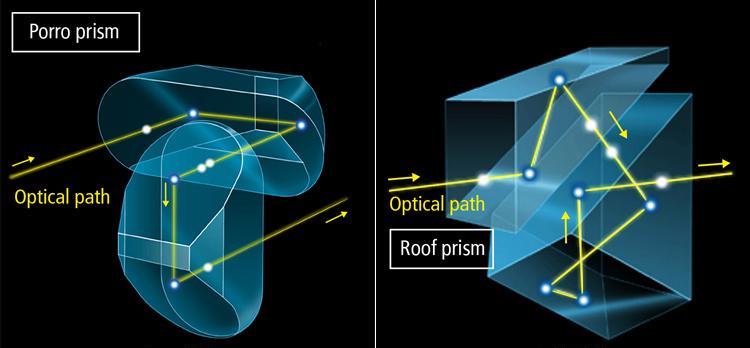Monoculars are compact optical devices that allow users to magnify distant objects by using a single lens system. Unlike binoculars, which require both eyes for viewing, monoculars are designed for use with only one eye, making them portable and easy to carry. The fundamental principle behind monoculars is their ability to bend light to create a magnified image of a distant object, making it appear closer and larger than it would to the naked eye.
A monocular telescope generally has a relatively straightforward structure, consisting of lenses, prisms, lens coating, eyecups, fixing devices, and other elements. However, have you ever wondered which of these components actually constitute the key structures? Understanding the significance of these key structures is essential for both appreciating the functionality of a monocular telescope and making informed decisions when it comes to choosing or using one.

At the core of any monocular is its optical system, which relies on a combination of lenses to gather, focus, and magnify light. Essentially, a monocular is a small, handheld telescope designed to allow one eye to view distant objects clearly. But, you do not have to worry about using one eye to see will be tired, most of the monoculars can be used with a mobile phone clip, not only can see, but also record at the same time.
The optical system: can be regarded as a comprehensive manifestation of the cumulative effects of all the lenses incorporated within it. It serves as the core element that determines the overall quality and performance of the device. When it comes to evaluating the efficacy of an optical system, one of the primary methods is through the careful observation of the field of view.

To commence with, direct your attention towards a building or any other object that exhibits a straight and well-defined geometric shape. The objective here is to meticulously examine whether this target appears distorted or bent when observed through the optical system. In an ideal scenario, a high-quality optical system will ensure that the field of view remains completely true to the original shape of the object, without any discernible warping or deformation. This is a crucial aspect as it directly impacts the accuracy and reliability of the visual information conveyed by the instrument.

Subsequently, shift your focus to the clarity of the field of view. It is essential to assess whether the entire expanse of the field, ranging from the outermost edges to the central region, presents a sharp and distinct image. If, during the inspection, you happen to notice that the periphery of the field of view appears hazy or indistinct, it is a clear indication that the optical system may possess certain deficiencies. Such blurriness at the edges can significantly impede the overall visual experience and limit the instrument’s usability, especially when attempting to observe objects that span a wide area or those located in the peripheral regions of the field.
Finally, another vital factor in determining the excellence of an optical system is the evaluation of the image’s brightness and color saturation. This becomes particularly pertinent in low light conditions, where the optical system is truly put to the test. A superior optical system will be capable of maintaining a sufficient level of brightness and vivid color reproduction, allowing the user to clearly discern the details and characteristics of the target even in challenging lighting environments. Additionally, the presence of a faint light in pale blue or light yellow hues at the very edge of the field of view, which is normal, especially for high-magnification monocular telescopes.

In conclusion, a comprehensive understanding and assessment of these various aspects related to the field of view are essential for both professionals and enthusiasts alike. By carefully examining the distortion, clarity, brightness, and color characteristics, one can make a more informed judgment about the quality and capabilities of an optical system, thereby facilitating the selection and utilization of optical instruments that best meet their specific requirements and expectations.
Objective Lens: This is the larger lens located at the front of the monocular. Its job is to collect light from the object you want to view and focus it onto the rest of the optical system. The quality and size of the objective lens determine how much light the monocular can gather, which affects the brightness and clarity of the image. But for the monoculars, do not pursue a large objective, usually not more than 50mm, otherwise the volume will become large and inconvenient to carry.
For waterproof monocular telescopes, an extra layer of waterproof lens is typically added to the exterior of the objective lens. This waterproof lens is firmly and immovably fixed within the monocular tube, and it has been meticulously processed with waterproof sealing measures. Such a configuration characterizes a waterproof monocular telescope. Nevertheless, it is essential that you assess whether you will frequently utilize the monocular telescope in rainy weather or in proximity to water bodies. If not, I would not advise you to purchase a waterproof monocular telescope. The reason being that the addition of this waterproof lens not only augments the production cost and the overall weight of the device but also leads to a reduction in the light transmittance. Consequently, the field of view that you perceive will be darker. Although a significant number of individuals may not be able to detect such a subtle alteration, it remains a factor that warrants careful consideration.
Eyepiece Lens: Located at the back of the monocular, the eyepiece lens further magnifies the image that has been focused by the objective lens. This lens is smaller and works to enlarge the image so that it appears closer and more detailed when viewed through the monocular.
Lens Coating: All the lenses of monocular telescopes are coated, which makes the lenses appear in colors like green, blue or red. The rationale behind this lies in the fact that sunlight is composed of seven distinct colors, and each light wave exhibits a different refractive index. To enable the passage of diverse light waves through the lenses, anti-reflection coatings are essential. These coatings are specifically tailored to different light waves. Consequently, high-quality monocular telescope lenses are typically multi-coated. When the coatings are applied to all the lenses of the objective lens, prism, and eyepiece lens, it is designated as Fully multi-coated, abbreviated as FMC. This explains the prevalence of promotional claims regarding FMC lenses that one commonly encounters.

One of the most important factors in understanding how monoculars work is how magnification affects the image you see.
The magnification of the monocular is determined by the relationship between the objective lens’s focal length and the eyepiece’s focal length. The greater the difference between these two focal lengths, the higher the magnification power. For example, a monocular labeled “10×25” indicates 10x magnification with a 25mm objective lens. A monocular with a magnification of 10x means that you can look at a target 10 meters away like looking at a target 1 meter away without a telescope. However, one thing needs to be noted in particular, the higher the multiple, the greater the field of vision jitter, the smaller the field of vision, and even the target cannot be seen. So in the absence of a tripod, it is correct to choose no more than 10 times the monoculars telescopes. The higher the magnification, the larger the image will appear, allowing users to see details from a great distance. However, a higher magnification may come with some drawbacks, such as a narrower field of view and potential image instability, especially when the monocular is handheld.

Field of View (FoV): The field of view refers to the area you can see through the monocular. It is usually measured in terms of width at a distance (e.g., 1000 yards). Magnification and field of view are inversely related: higher magnification typically results in a narrower field of view. Therefore, monoculars with lower magnification, such as 6x or 8x, provide a broader view of the scene, while higher-magnification monoculars (e.g., 12x or 16x) focus on a smaller, more detailed portion of the view.
The field of view also depends on the size of the objective lens. Larger objective lenses can gather more light and can provide a wider field of view, but they also make the monocular bulkier and heavier. The trade-off between magnification and field of view is important to consider when selecting a monocular for specific activities like birdwatching (where a wide field of view is often more useful) versus hunting (where higher magnification might be necessary for precise targeting).
If you want to see far and have a good field of view, there is a great solution, Zoom Monoculars. For example, 8-24×40 Monocular. You can search for the target at 8x and observe the target details at 24x. This is a good choice. But the price will be higher, and the field of view will be further reduced than the same times of monoculars.

Roof Prisms: Roof prism monoculars are characterized by a straight-barrel design, where the light travels in a straight line. These monoculars are compact, lightweight, and ideal for high-end models, offering better durability and portability. The roof prism design, while more complex, allows for a more compact structure, making them easier to carry for long periods. However, they are often more expensive due to the precision required in their construction.
Porro Prisms: Porro prism monoculars use a more traditional design, where the light path is bent at angles, giving the monocular a wider, more angled shape. These monoculars are generally bulkier but offer a wider field of view and are less expensive to produce, making them a more affordable choice for budget-conscious users.
The prism system plays a vital role in image quality, helping to ensure that the final image is upright and correctly oriented. Without the use of prisms, the image would appear upside down, which would make viewing objects difficult and disorienting. It should be emphasized that in the case of monocular telescopes equipped with roof prisms, any attempt to enhance the optical performance invariably leads to a rather rapid escalation in price. To begin with, high-end monocular telescopes typically necessitate the utilization of BAK4 prisms. It is worth noting that there exist other prism materials as well, such as BK7 and BK9, among others. Secondly, the manufacturing process of roof prisms is highly intricate. When light traverses the reflective surfaces of the prisms, the angles of the prisms must be of utmost precision. Even the slightest deviation in the angles can give rise to light loss and scattering phenomena, which subsequently have a detrimental effect on the brightness and clarity of the observed image. This, in turn, imposes an extremely demanding standard on the manufacturing process. In order to mitigate light loss, it becomes essential to apply anti-reflection coatings, phase coatings, silver coatings or dielectric coatings to specific surfaces of the prisms. However, it is an inescapable fact that the incorporation of these coatings substantially drives up the overall cost.

While traditional monoculars rely on basic optical systems with lenses and prisms, modern monoculars have embraced cutting-edge technology to enhance performance, especially in challenging conditions. Some of the latest innovations include:
Image Stabilization: A novel approach is to pair a monocular with a smartphone. By leveraging the image stabilizer of the smartphone, the monocular can achieve a clearer image. Many modern smartphones are equipped with advanced image stabilization mechanisms that can counteract the shakes and vibrations. When combined with a monocular, the smartphone’s image stabilizer compensates for the hand movements that would otherwise cause blurriness in the view through the monocular. This is especially advantageous when using high-magnification monoculars, as the slightest hand tremor can be highly amplified in the viewfinder, but with the assistance of the smartphone’s image stabilizer, a more stable and sharp visual experience can be obtained.
Night Vision: When the monocular telescope is equipped with sensors, sensors, and infrared lights, it becomes a telescope that can be observed at night. Digital or infrared monoculars use night vision technology to allow users to see in low-light or completely dark conditions. These monoculars use infrared (IR) light to illuminate the scene, allowing for clear visibility even in complete darkness. They are commonly used by military personnel, law enforcement, and outdoor enthusiasts for activities like night hiking or surveillance.
Digital Monoculars: With advancements in digital technology, some monoculars now feature electronic sensors and built-in displays that provide high-resolution images. These digital monoculars may also offer additional features such as digital zoom, photo capture, and even video recording. They can be useful in a range of professional applications, including surveillance and wildlife monitoring.

Conclusion
Monoculars are simple yet effective tools for magnifying distant objects using lenses and prisms. They operate on the principle of light bending, where the light from a distant object is gathered by the objective lens, focused, and then magnified by the eyepiece lens. Their magnification and field of view depend on the quality and size of the lenses, while the prism system ensures the image appears upright and properly oriented.
Recent technological advancements have made monoculars more versatile, with features like image stabilization, night vision, and digital zoom, increasing their utility for a wide range of activities. Whether used for outdoor adventures, professional surveillance, or even casual sports viewing, monoculars remain a popular and indispensable tool for bringing distant objects into clearer view.
Monoculars are widely used for outdoor activities such as birdwatching, hiking, and hunting because of their portability and ease of use. They also find practical applications in other areas, such as military reconnaissance, law enforcement surveillance, and even in sporting events for a closer view of distant actions.
You can click on my Home page to see the various monoculars we have prepared for you. If you want to know how to tell a good monoculars or binoculars, Please contact us.






